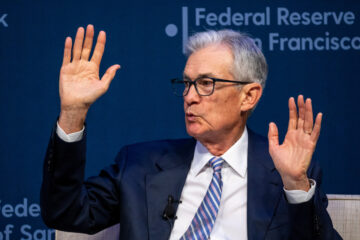Stagflation was a big part of the conversation in financial markets during 2022-23, but no more.
The term refers to a combination of high inflation and stagnant economic growth. But those ills are absent in the current environment.
Don’t miss the move: Subscribe to TheStreet’s free daily newsletter
Just last week the government reported that nonfarm payrolls rose 254,000 in September from 159,000 in August. And the unemployment rate dipped to 4.1% from 4.2%. Those numbers exceeded expectations.
So the economy is looking pretty good, with the Atlanta Federal Reserve Bank’s forecasting model calling for 3.2% annualized GDP growth in the third quarter. That’s up from actual growth of 3% in the second quarter.
Economist Nouriel Roubini gained acclaim for predicting the 2007-09 financial crisis
Calm inflation picture
The inflation front is looking pretty good, too. Consumer prices rose 2.4% in the 12 months through September. While that slightly exceeded economists’ forecasts, it’s down from 2.6% in August.
The Fed has a 2% target for inflation. And its favored inflation indicator, the personal consumption expenditures price index, was very close to that mark in August – 2.2% year on year.
Put it all together and “investors should be reassured that the economy is doing well, the labor market and consumer spending are both holding up well, and there doesn’t appear to be any signs of recession,” Chris Zaccarelli, chief investment officer at Independent Advisor Alliance, wrote in a commentary.
Related: Druckenmiller, Summers deliver blunt messages to Fed on interest rates
Personal consumption spending gained 0.2% in August from July.
The Fed slashed interest rates by 0.5 percentage point last month to prevent a recession. But after the most recent economic numbers, experts expect a smaller cut in the Fed’s next meeting Nov. 6-7.
Interest rate futures show an 80% probability that the central bank will trim by 25 basis points (0.25 percentage point) next meeting and a 20% probability of no change.
‘Disinflation continues,’ analyst says
“Disinflation continues, but anyone who thought the Fed was going to lower rates by another 50 basis points in November is dead wrong,” Jamie Cox, managing partner at financial advisory firm Harris Financial Group, wrote in a commentary.
“When interest rates aren’t high enough to lower growth, they aren’t high enough to stifle inflation completely either. The Fed will lower rates, but at a measured pace from here.”
Related: Debate erupts over how fast to cut interest rates
Meanwhile, the possibility of stagflation may be off the table for now. But it could come back again soon, depending on the policies of Kamala Harris or Donald Trump.
Each has called for hefty public spending increases and tax cuts, both of which are inflationary. And if the Fed has to raise rates to combat such inflation, that could depress economic growth.
Roubini sees Trump creating bigger stagflation risk
So which candidate poses a bigger economic threat?
“The combination of trade, currency, monetary, fiscal, immigration and foreign policy of Trump poses much higher risks of stagflationary outcomes than if Kamala Harris is elected,” economist Nouriel Roubini said at a conference this week, according to Bloomberg.
“Trade” refers to tariff increases Trump has promised, which are inflationary. “Currency” refers to Trump’s preference for a weaker dollar, which also is inflationary.
More Economic Analysis:
Goldman Sachs analyst overhauls S&P 500 targets for 2024, 2025PCE Inflation report resets bets on another big Fed rate cutWhy stocks are soaring and the rally has room to run
“Immigration” refers to Trump’s threat to kick out illegal immigrants and make sure others don’t enter. That could lead to a labor shortage, which could boost inflation and stifle economic growth.
To avoid harm, Roubini recommends investors buy gold, short-term bonds and Treasury inflation-protected securities.
He made his name by correctly predicting the 2007-09 financial crisis, earning him the moniker “Dr. Doom.”
Related: The 10 best investing books, according to our stock market pros


